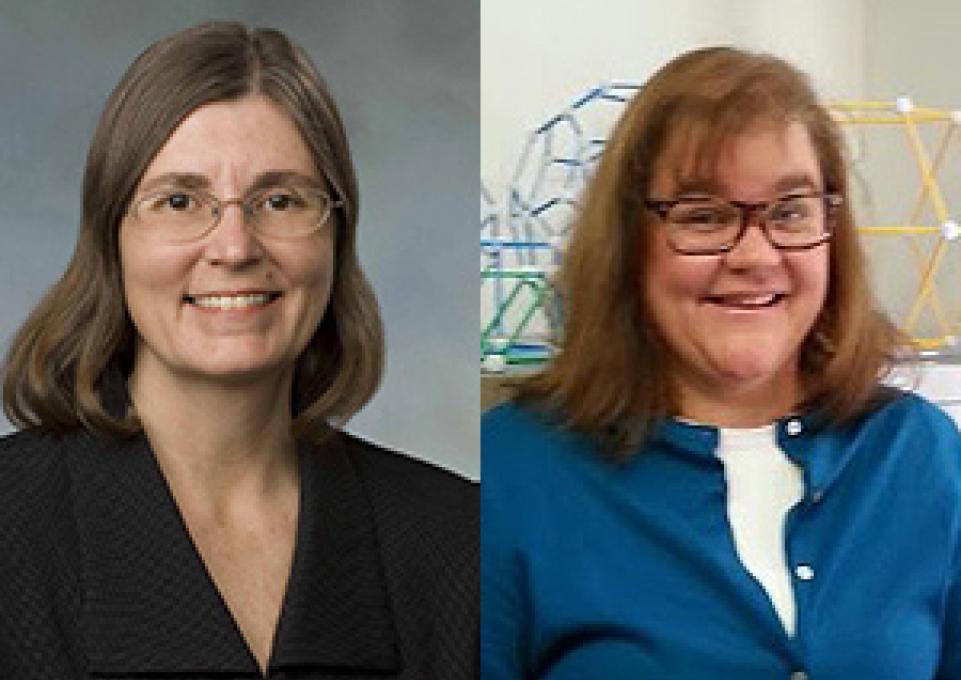
When math scores improve, it’s exciting news for Susan McMillen, professor (pictured at left), and Jodelle Magner, associate professor (at right), both in the Mathematics Department at Buffalo State. For the last three years, they worked closely with about 100 teachers and 14 administrators from Buffalo schools to provide professional development to math teachers of students in grades 3 to 6. In one school where 18 languages (plus English) are spoken, math scores increased by double digits in some grades.
McMillen and Magner were co-directors of the $2 million Math Science Partnership grant from the New York State Department of Education. This grant cycle started in September 2014 and ended in June 2017, the last of a series of grants benefiting the Buffalo Public Schools over a 14-year period.
Every other month, the two professors presented day-long professional development sessions to teachers and administrators interested in deepening their mastery of content and finding new ways to present it. McMillen and Magner also worked closely with a leadership team to get feedback and to develop content and tools in response.
“Too often, students think math is a series of rules that has no relationship to the real world,” said McMillen. “One reason that Common Core emphasizes concepts rather than rote learning is that, if you truly understand the concept, you can apply it whenever you need it.”
Dice, Discussion, and Dollar Stores: Non-Traditional Ways to Teach Math
Sometimes that means working backward from the “real world.”
“You might take a photograph of, say, soup cans on shelves,” said McMillen. “Four cans each on a shelf—what’s the math concept here? It could be simple addition, or it could be an equal number of cans multiplied by the number of shelves.”
Magner is a fan of low-tech teaching props—dice, clotheslines, and shower liners from dollar stores. “We used the funds to buy 10-sided dice for teachers, so they would have all the digits,” she said. The grant also funded substitute teachers. “Several special education teachers came,” she said. “That’s really exciting because they need a variety of teaching tools to match their students’ different abilities.”
Student workstations, which enable students to work together in small groups, were especially popular. “In this model,” said McMillen, “the teacher talks less and the students talk more. We demonstrated it by asking the teachers to work together in groups. We’re used to thinking of math as having just one right answer, but the small-group model allows people to explore why an answer is wrong. That’s a learning experience right there, and it makes people less afraid to make a mistake. The teacher goes from group to group and helps students figure out the concept.”
Another idea they presented was kinesthetic learning—learning that involves touching and movement. Shaking up dice, for example, is a way to present numbers and mathematical ideas through an activity that goes beyond the traditional pen and paper. The clothesline can serve as many things, including a number line. By pinning numbers to the string, students can see where the 3 and the 7 belong. Later, it can serve to illustrate the relative value of fractions and decimals. McMillen said it can even be used to teach high school students to solve algebraic problems.
“These visual aids are especially important for students who are English language learners,” said Magner. “They can grasp the math concepts even if they haven’t acquired the language skills to decipher word problems, like the classic about ‘two trains leaving the station.’
The shower curtain liner? “This was one of the ideas the teachers came up with for parents to use at home,” said McMillen. “You can print the ABCs on one side and numbers on the other side, and children can use it to learn spelling and arithmetic.”
Shared Labor of Love
“The administrators were great, and they stayed the course,” said McMillen. “They helped the teachers implement different teaching methods. They tried different things, too, like developing a team of teachers specializing in math instruction or in coaching math teaching.”
Both McMillen and Magner are specialists in math education, and they share a commitment to urban education. “I especially like working with elementary grade teachers,” said Magner, “because they are so enthusiastic, and they are quick to share that enthusiasm with their students.”
Additional Information
This contract is administered by the Sponsored Programs Office, which has moved to Buckham Hall B206.
